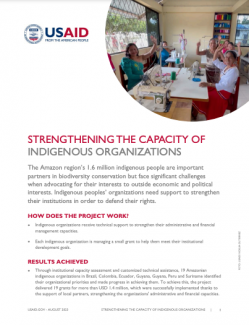The Amazon region’s 1.6 million indigenous people are important partners in biodiversity conservation but face significant challenges when advocating for their interests to outside economic and political interests. Indigenous peoples’ organizations need support to strengthen their institutions in order to defend their rights.
HOW DOES THE PROJECT WORK?
Indigenous organizations receive technical support to strengthen their administrative and financial management capacities.
Each indigenous organization is managing a small grant to help them meet their institutional development goals.
RESULTS ACHIEVED
- Through institutional capacity assessment and customized technical assistance, 19 Amazonian indigenous organizations in Brazil, Colombia, Ecuador, Guyana, Guyana, Peru and Suriname identified their organizational priorities and made progress in achieving them. To achieve this, the project delivered 19 grants for more than USD 1.4 million, which were successfully implemented thanks to the support of local partners, strengthening the organizations' administrative and financial capacities.
- These grants had diverse focuses, highlighting the diversity of the Amazon and its indigenous peoples, such as learning the language and traditional medicine, strengthening productive projects of cocoa, guayusa and textiles, training in legal issues and indigenous rights, empowerment of women and youth, among others.
- More than 1,390 people from 17 participating indigenous organizations strengthened their capacities in knowledge areas such as project formulation, accounting and finance, organizational communication, georeferencing, indigenous territorial and cultural rights, among others. The participation of women in these trainings was 48%.
- Participatory tools like the Institutional Capacity Assessment (ITOCA) and the Organizational Performance Index (IDO), were adapted to take into account the worldview and context of the participating indigenous peoples, allowing a differential application in each territory.
- Supporting the improvement of communication equipment allowed better communication between members of the communities and their organizations resulting in improved governance for collective decision making.
- Some of the participating indigenous organizations identified a close relationship between involving young people in decision-making and participation spaces and the future sustainability of their organizations. Likewise, women were more listened to and involved in these processes as leaders in decision making within the economic and social boards.

